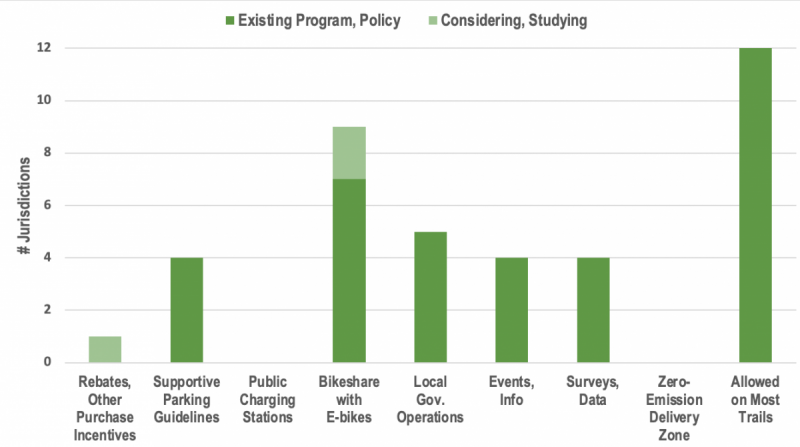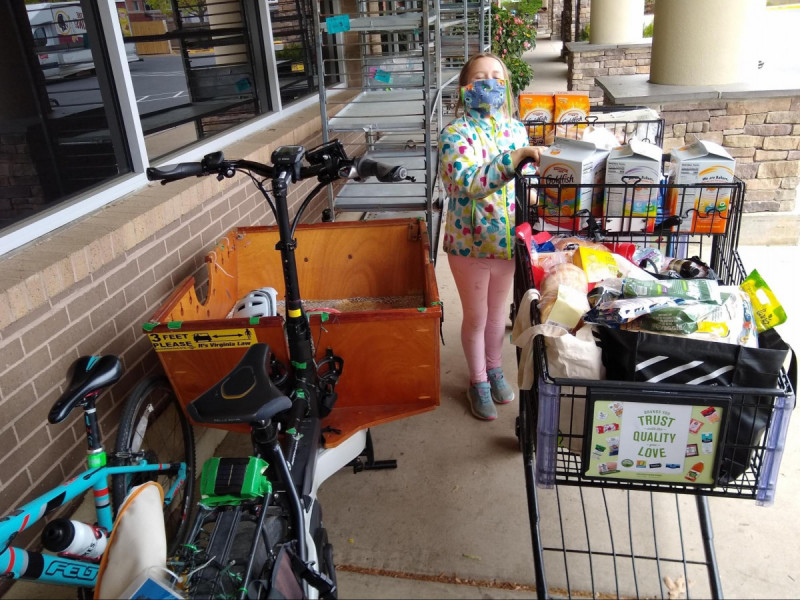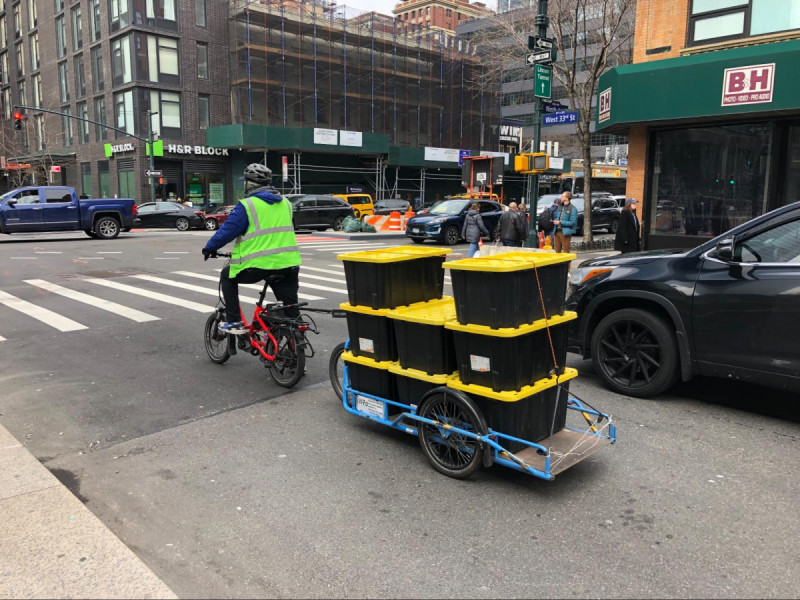Electric-assist bicycles, or e-bikes, are extending the reach of bikes to more people, more destinations, and more trips that used to be done by car. Americans are buying well over a million e-bikes each year, more than the 800,000 electric vehicles purchased in 2022. In Denver, Colorado, a new program to help residents of all income levels access e-bikes was replacing over 100,000 miles of car trips per week after less than a year since its start.
The benefits of this transportation mode are impressive and growing – convenience, sustainability, affordability, health, and fun. Over half of the daily trips we make in the US are within bikeable distances of three miles or less, and over a quarter are under a mile. Even with the needed shift to electric vehicles, our region has to reduce per capita driving 20% to meet its climate targets, and that’s with a population projected to grow by almost 1.5 million new residents by 2050.
Shifting trips to walking and biking through active transportation investments and land use planning is perhaps the most cost effective way to reduce transportation emissions. Plus, e-bikes use a tiny fraction of the limited and often environmentally costly battery minerals that go into e-cars. Many residents can’t afford an electric car (or any new car) – and already shell out a lot on cars, reducing our region’s affordability – but can afford an e-bike.
How to bring the benefits of e-bikes to more people
For all biking, with electric assist or just pedal power, the biggest obstacle is the lack of protected on-street or off-street spaces in which to ride. Institutional factors that limit access for communities of color, women, and lower-income neighborhoods are also an issue.
For e-bikes specifically, there are other factors affecting adoption: higher cost, often increased weight, bigger size of cargo e-bikes, and lack of familiarity for many people.
Local communities can address these barriers through:
- Rebates and other incentives to help defray up-front higher costs
- Secure and accessible parking, particularly for heavier e-bikes or larger cargo e-bikes
- Charging – public charging stations are not yet a major need but education on safe charging for any battery-powered devices could help (as could more federal consumer protections against substandard batteries)
- Shared e-bikes and lending programs for cargo bikes
- Use for local government needs
- Events and outreach to show modern e-bike options and let people try them out
- Data on use, travel patterns, and other needs
- Piloting zero-emission loading and delivery zones
- Clear regulations for use on trails, other areas
What is Greater Washington doing?
The Coalition for Smarter Growth and our winter intern from Episcopal High School surveyed and interviewed local jurisdiction transportation staff from across the National Capital region to find out what their communities are doing (with more details in our e-bike white paper). Here are the main ways that local governments are currently addressing the needs of e-biking:
DC-Area jurisdictions with supportive programs and policies for e-bikes

Coalition for Smarter Growth, survey of local government staff, Jan-Feb. 2023
Overall, the District of Columbia, Arlington County, City of Alexandria, Fairfax County, and Montgomery County have done the most to incorporate e-bikes in their transportation programs and development planning, with parking facility guidance, public events, and bikeshare programs.
Urban trail access came up as an issue several years ago, with most regional jurisdictions and the National Park Service allowing common types of e-bikes on popular hard-surface trails. Prince George’s County had a pilot program allowing e-bikes in several parks and trails but it expired in 2021, and some smaller jurisdictions have not yet clarified park and trail rules.
Let’s look at a few specific strategies and which local jurisdictions are employing them.
Purchase rebates
E-bikes typically cost in the range of $2,000 to $4,000, double or triple the cost of a typical pedal bike (but significantly lower than the $28,000 to $100,000 cost of an electric vehicle). Denver’s successful point-of-sale rebate program, and the growing number of programs nationwide, help lower the cost and level the playing field by prioritizing assistance to lower income residents. It has proven to be very effective and popular.
DC is currently considering two e-bike rebate bills that would provide varying levels of rebates at the time of purchase, up to $750 for a standard e-bike and up to $1,500 for a cargo e-bike for DC residents, with those rebates doubled for lower-income residents. A few other jurisdictions have had staff-level discussions but no formal proposals yet.
Well-structured e-bike incentive programs can deliver major benefits to lower-income commuters. Most of the Denver rebate funds have gone to low-income residents, who then use their purchased e-bikes 50% more than other participants.
Meanwhile, almost all of the $7,500 federal electric vehicle rebates will help people buy expensive SUVs and pickups that pose real dangers to pedestrians, bicyclists, and other drivers. E-bike purchase rebates are far cheaper, support more sustainable travel, and are more likely to achieve their desired outcome.
Parking
Secure and accessible bike parking in apartments and offices, while a need for all bikes, can be more important for pricier and often heavier e-bikes. Cargo e-bikes need longer and often wider bike parking spaces, similar to bikes with trailers and other special bikes (e.g., adult trikes) that accommodate personal needs.
The District of Columbia, Fairfax County, Montgomery County, and Arlington County have varying degrees of requirements and guidance for off-street bike parking in new developments that can accommodate these longer or wider bikes. Specific uses like supermarkets or daycares that attract cargo bikes or bikes with trailers should also consider bike rack spacing to accommodate them.

Shopping by e-bike in Arlington. Photo courtesy of Gillian Burgess.
Charging
Public charging on the street is not a major need, like it is for e-cars, since bikes and detachable batteries with their charging adaptor can be plugged into any wall socket, typically at home or work. And even with a dead battery, a cyclist can pedal home (something a car driver can’t do, the Flintstones notwithstanding).
However, it is worth noting that in the UK and continental Europe, public charging stations for long-distance bike touring have become a way to attract riders into countryside towns to juice up their bikes while patronizing the local bistro. What would stop communities along our C&O Canal Towpath and East Coast Greenway trails from looking into this too?
Electric outlets in bike storage areas of offices and apartments can allow for a quick battery juice-up (for e-bikes as well as bike lights and phones) while retrieving or parking a bike. This is especially convenient for a few e-bikes that have batteries integrated into the frame. Montgomery County requires, and the District of Columbia has guidance for, providing electrical outlets in off-street bike parking facilities in larger new developments with long-term bike parking.
Battery safety
Battery safety for e-bikes is something to take seriously, as it is for electric scooters, electric cars, phones, or any personal device with a lithium-ion battery. No batteries should be left unattended charging for long periods. Kea Wilson at Streetsblog provides a good overview of fire incidents and issues with substandard e-bike batteries and the food delivery industry in New York City in particular. Bikes, batteries and chargers from reputable major brands and retailers that are properly used and maintained are generally safe and without problems.

E-bike goods delivery in New York City. Image by author.
The role of bikeshare
Several challenges with personally owned e-bikes – secure parking, upfront cost – can be addressed through robust bikeshare programs like Capital Bikeshare and dockless services. However, shared and personally owned e-bikes can also play complementary roles, because they serve different types of trips.
Data from Denver show that residents who purchased e-bikes through the rebate program take longer trips on average (3.3 miles), and those trips are more spread out across the week compared to users of the city’s bikeshare system. Denver’s shared bike and scooter program continued to increase in ridership even with the advent of the rebate program.
Other strategies
Other roles our local governments can play include:
- Government operations: DDOT and Arlington County have cargo bikes, and the Prince George’s County Department of Parks and Recreation uses electric and other bikes. Several jurisdictions offer free or discounted Capital Bikeshare memberships to staff as commuter benefits.
- Events: Arlington, Alexandria, and Fairfax County have done e-bike demonstrations as part of public festivals and other events (check out Alexandria’s e-bike showcase May 20). Montgomery County has provided learn-to-ride classes that include e-bikes and scooters as well as pedal bikes.
- Lending libraries: Outside of our region, cities like Oakland and the State of Vermont, have initiated cargo bike and e-bike lending programs, where residents can check out an e-bike for a day or more. Closer to home, there’s a community-run Charlottesville e-bike lending library, and Montgomery County, Maryland, is considering a cargo bike pilot program.
- Goods delivery: Last-mile delivery by cargo bikes and designated zero-emission loading zones that allow bikes as well as electric vans are being piloted by cities and shipping companies to reduce traffic and pollution and speed up deliveries.
With May as national bike month, let’s celebrate how far biking has come in the region, but also consider the host of ways our communities can make e-biking – and all biking – easier, safer, and the climate solution it can be. And then let’s continue to encourage our local officials to do more.
